Efficient tree-based content-based routing schemes
- Khazaei, Koorosh
- Carzaniga, Antonio (Degree supervisor)
-
05.02.2018
128 p
Thèse de doctorat: Università della Svizzera italiana, 2018
GPU
Content-based
Subset matching
ICN
Tag-based
Multi-tree routing
Content-centric
Information-centric networking
Forwarding
English
This thesis is about routing and forwarding for inherently multicast communication such as the communication typical of information-centric networks. The notion of Information-Centric Networking (ICN) is an evolution of the Internet from the current host-centric architecture to a new architecture in which communication is based on “named information”. The ambitious goal of ICN is to effectively support the exchange and use of information in an ever more connected world, with billions of devices, many of which are mobile, producing and consuming large amounts of data. ICN is intended to support scalable content distribution, mobility, and security, for such applications as video on demand and networks of sensors or the so-called Internet of Things. Many ICN architectures have emerged in the past decade, and the ICN community has made significant progress in terms of infrastructure, test-bed deployments, and application case studies. And yet, despite the impressive research effort, the fundamental problems of routing and forwarding remain open. In particular, none of the proposed architectures has developed truly scalable name-based routing schemes and efficient name-based forwarding algorithms. This is not surprising, since the problem of routing based on names, in its most general formulation, is known to be fundamentally difficult. In general, one would want to support application-defined names (as opposed to network-defined addresses) with a compact routing scheme (small routing tables) that uses optimal paths and minimizes congestion, and that admits to a fast forwarding algorithm. Furthermore, one would want to construct this routing scheme with a decentralized and incremental protocol for administrative autonomy and efficient dynamic updates. However, there are clear theoretical limits that simply make it impossible to achieve all these goals. In this thesis we explore the design space of routing and forwarding in an information-centric network. Our purpose is to develop routing schemes and forwarding algorithms that combine many desirable properties. We consider two forms of addressing, one tied to network locations, and one based on more expressive content descriptors. We then consider trees as basic routing structures, and with those we develop routing schemes that are intended to minimize path lengths and congestion, separately or together. For one of these schemes based on expressive content descriptors, we also develop a fast forwarding algorithm specialized for massively parallel architectures such as GPUs. In summary, this thesis presents two efficient and scalable routing algorithms for two different types of networks, plus one scalable forwarding algorithm. We summarize each individual contribution below: Low-congestion geographic routing for wireless networks. We develop a low-congestion, multicast routing scheme designed specifically for wireless networks. The scheme supports geographical multicast routing, meaning routing to a set of nodes addressed by their physical position. The scheme builds a geometric minimum spanning tree connecting the source to all the destinations. Then, for each edge in this tree, the scheme routes a message through a random intermediate node, chosen independently of the set of multicast requests. The intermediate node is chosen in the vicinity of the corresponding edge such that congestion is reduced without stretching routes by more than a constant factor. Multi-tree scheme for content-based routing in ICN. We develop a tree-based routing scheme designed for large-scale wired networks such as the Internet. The scheme supports two forms of addresses: application-defined content descriptors, and network-defined locators. We first show that the scheme is effective in terms of stretch and congestion on the current AS-level Internet graph even with only a few spanning trees. Then we show that our content descriptors, which consist of sets of tags and that are more expressive than the name prefixes used in mainstream ICN, aggregate well in practice under our scheme. We also explain in detail how to use descriptors and locators, together with unique content identifiers, to support the efficient transmission and sharing of information through scalable and loop-free routes. Tag-based forwarding (partial matching) algorithm on GPUs. To accompany our ICN routing scheme, we develop a fast forwarding algorithm that matches incoming packets against forwarding tables with tens of millions of entries. To achieve high performance, we develop a practical solution for the partial matching problem that lies at the heart of this forwarding scheme. This solution amounts to a massively parallel algorithm specifically designed for a hybrid CPU/GPU architecture.
- Language
-
- English
- Classification
- Computer science and technology
- License
-
License undefined
- Identifiers
-
- RERO DOC 323041
- URN urn:nbn:ch:rero-006-117590
- ARK ark:/12658/srd1318758
- Persistent URL
- https://n2t.net/ark:/12658/srd1318758
Statistics
Document views: 312
File downloads:
- Texte intégral: 189
